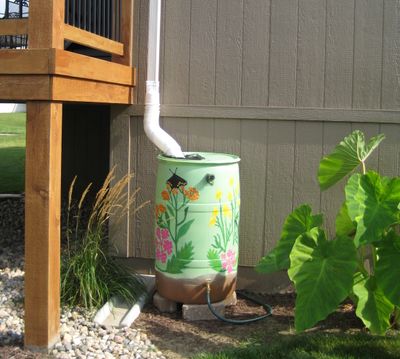Rain-barrel system proves easy, effective
Capturing and reusing rainwater good for both plants and environment

Robin Blair does what she can to help her plants thrive. She plants them in good soil and keeps the weeds away. She also waters them regularly with rainwater captured in barrels in the yard of her Shrewsbury, N.J., home.
Collecting the water is easy, she says, and good for her plants and the environment.
“Rainwater is void of chemicals. It’s kinder to plants and landscaping,” said Blair, who has two rain barrels and a cistern tied into her gutter system. “Water is a precious resource. Why not collect rainwater and reuse it?”
Blair is such a proponent that she got trained to teach other gardeners how to make and use rain barrels. When she organized a workshop last spring, she was surprised at how many people wanted to attend. “We kept getting more and more orders,” she said.
Rain-barrel use and classes are on the rise around the country, according to gardening and conservation experts. Although the concept of capturing and reusing rainwater has existed for thousands of years, many gardeners and environmentalists are revisiting it because of concerns about stormwater runoff and water conservation.
“It’s one of our more popular classes,” said Madeline Samec, a horticultural program assistant with the St. Johns County Extension Agency in St. Augustine, Fla. “We almost don’t have to advertise.”
Most rain barrels hold around 55 gallons of water and are connected to a downspout. They normally have an overflow pipe that detours excess water away from a home’s foundation, and a filter that prevents mosquitoes from entering. Rain barrels also have a tap that can be used to fill watering cans or connect to a hose.
A 55-gallon barrel connected to a 1,000-square-foot roof will fill up during a 1-inch rain. The barrels can be purchased for $50 to $120 each, or constructed out of food-grade drums.
In addition to watering the garden, some people use rainwater for koi ponds or aquariums, said Dotty Woodson, extension program specialist for water resources at Texas AgriLife Extension Service in Dallas.
She said many rain-barrel users like that rainwater does not contain chlorine, fluoride or other chemicals that municipalities use to treat water. While investing in a rain barrel does help the environment, it’s not likely to shave a lot off a homeowner’s water bill, Woodson said.
“People might come to the class with the idea that it’s going to save them money but we’re very, very honest about that,” she said. “It won’t have a huge impact. The environmental issue is what we’re looking at.”
A rain barrel can be connected to a gutter system without too much difficulty, the experts said. First, homeowners need to remove a section of downspout and replace it with flexible tubing. When the rain barrel is in use, the tubing should run from the downspout to the barrel. When the rain barrel is not in use, the tubing should reconnect back to the downspout.
Rain barrels are “a very easy way to go green,” said Mandy Stark, marketing and outreach specialist for the city of Lenexa, Kan., which promotes their use through a public art display. Every summer, the city places painted rain barrels around town to encourage residents to install them.
Those who do “feel they’re making a tangible difference – that they’re actually doing something that protects the environment,” Stark said.
Many municipalities experience a 30 percent to 40 percent increase in residential water usage in the summer. Rain barrels can help reduce that.
Diverting and collecting rainwater also lessens water pollution in streams, rivers and lakes. When rainwater travels over impervious surfaces – such as parking lots, roads and driveways – it collects pollutants, which often end up in local bodies of water.
Rain barrels don’t require much maintenance, said Jen Willoughby, an environmental educator with the Interstate Commission on the Potomac River Basin, in Rockville, Md.
Just make sure to keep the screen clean throughout the season, she said. And in cold climates, disconnect the barrels and store them upside down during the winter.
Paul Hlavinka, president of the Muddy Branch Alliance, an environmental group in Gaithersburg, Md., agrees that rain barrels are a relatively easy way to make a difference.
“I love to go out and look at it,” he said. “You don’t realize how much water is coming off your roof until you go out and look.”